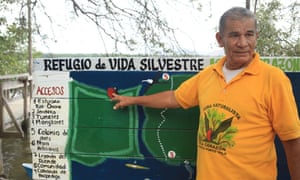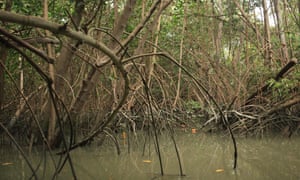de CarÁquez, a community project has restored mangrove forests – and may help save it from one of the strongest ever El Niños
The canoe sliced through the water and along a quiet, narrow tunnel enclosed by mangrove trees. As the craft slid past the spindly tree trunks and roots sticking several feet out of the water, tour guides pointed out ibis, herons and small red crabs hidden among the foliage.
Leading this tour was Francisco Reyes Mera, a former fisherman who helped found a group to restore the ravaged mangrove forests in his community. The result is the expansion of Isla CorazÓn, a naturally heart-shaped mangrove island in the estuary of the Rio Chone on Ecuador’s Pacific coast. The island is just outside BahÍa de CarÁquez, a resort-city where visitors come to enjoy the beach, surf and fill up on seafood. The town declared itself an eco-city in 1999, and eco-tourism sites such as Isla CorazÓn are popular destinations.
The Rio Chone was once thick with mangroves, creating prime habitat for the fish, wild shrimp, crabs and molluscs that the fishermen relied on. In the 1970s and 80s the bulk of the forests were ripped out, however, and replaced by shrimp farms, precipitating an economic boom but eliminating the storm-buffering effects, erosion control and wildlife habitat provided by the mangroves. Various studies have reported that somewhere between 75% to 90% of the mangroves in the estuary were removed during the shrimp farm explosion.

Tour guide and former fisherman Francisco Reyes Mera
The community paid the price in 1997-98, when El Niño brought months of heavy rain, provoking massive mudslides, filling the river with silt and sweeping away entire neighbourhoods. In the aftermath, a group of fishermen led by Reyes Mera began planting mangroves to protect their land and livelihood. “What choice did we have?” he says. “We just started planting.”
At the time, there were only 53 hectares of natural forest remaining at Isla CorazÓn. Since then, the community’s efforts have contributed to over 500 hectares more, and the group teamed up with Ecuador’s Ministry of Environment to make the island an officially protected wildlife refuge in 2002.
During the tour, the canoe emerged from the mangrove tunnel to the river on the south side of the island, where a strong smell of guano and muted squawking announced a large colony of frigate birds living in the trees. The black and white seabirds circled over the river looking for fish, and perched with their wings spread wide and hooked beaks agape. Other species, including brown pelicans and cormorants, also rested among the leaves.

Mangrove trees dip into the water near Isla CorazÓn
The tour concluded with a short hike down a wooden platform built into the island, and back into the centre of the forest. Reyes Merea handed out mangrove seeds for the guests to launch into the mud, where they will start to root in about 45 days – and contribute to the ongoing restoration of the environment.
Today, with the region bracing itself for the first strong El Niño since the 1998 disaster, the mangroves are more important that ever. The forests are still nowhere near their historic levels, and nearby towns remain vulnerable, but hopefully the mangroves will absorb some of the damage. “We’re worried for the community,” Reyes Mera says, “but the forests will be fine.”

